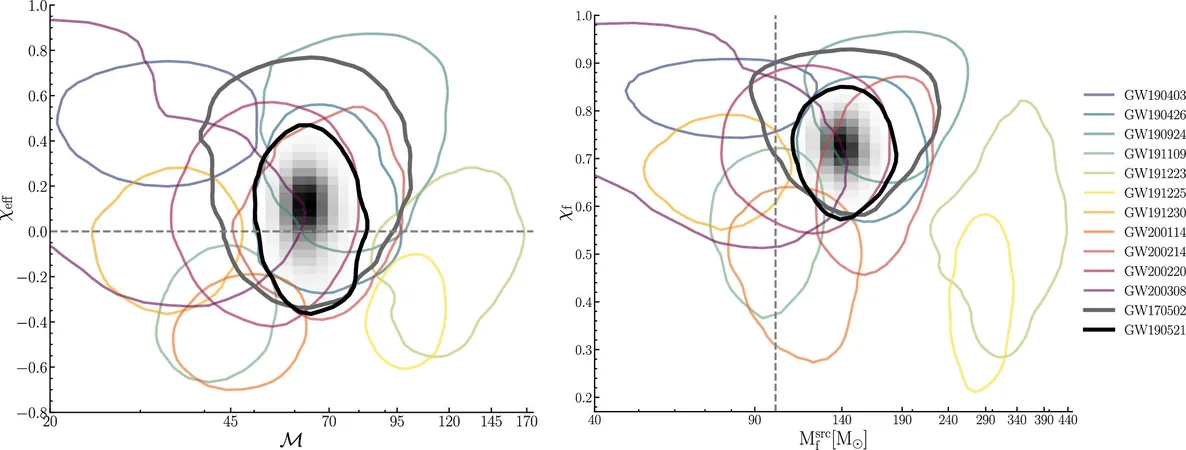
Groundbreaking Discoveries in the Hunt for Mysterious Intermediate-Mass Black Holes!
2025-05-30
Author: Wei Ling
Unearthing the Secrets of the Cosmos
In the cosmic arena, black holes are usually categorized by size into three primary groups: stellar-mass black holes, which boast a mass ranging from five to fifty times that of our sun; supermassive black holes, often reaching millions or even billions of solar masses; and the elusive intermediate-mass black holes that exist in a nebulous middle ground. While the existence of these mysterious middleweights is widely accepted, their origins and characteristics have remained one of the biggest enigmas in astrophysics.
Revolutionary Research Unveils New Insights
Recent studies led by a dynamic team under Assistant Professor Karan Jani at Vanderbilt University are changing the narrative. Published in the prestigious *Astrophysical Journal Letters*, the leading paper titled *Properties of 'Lite' Intermediate-Mass Black Hole Candidates in LIGO-Virgo's Third Observing Run* reveals groundbreaking findings related to these cosmic anomalies. The research team meticulously reexamined data gathered from the groundbreaking Laser Interferometer Gravitational-Wave Observatory (LIGO) in the U.S. and the Virgo detector in Italy.
Their findings confirm that the detected gravitational waves are linked to the mergers of black holes weighing between 100 and 300 times the mass of the sun, marking these events as the most massive ever documented in astronomy.
The Cosmic Fossils of the Universe
Assistant Professor Jani aptly describes black holes as the "ultimate cosmic fossils," stating, "The masses reported in this study have long been a matter of speculation. This newfound class of black holes offers an extraordinary glimpse into the universe's earliest stars." While earthly detectors like LIGO capture fleeting moments during these black hole mergers, understanding how they form remains a conundrum.
LISA: The Future of Black Hole Exploration
To tackle these profound questions, Jani's lab is preparing for the European Space Agency and NASA's ambitious Laser Interferometer Space Antenna (LISA) mission, set to launch in the late 2030s. This revolutionary satellite will help track black hole mergers long before they collide, providing invaluable insights into their formation and evolution.
Innovations in Gravitational Wave Detection
In a series of additional studies published in *The Astrophysical Journal*, a team led by Ruiz-Rocha explored the capabilities of LISA in monitoring 'stellar-origin' black hole binaries. Another project, led by intern Shobhit Ranjan, showcased multiband gravitational-wave measurements that could enhance our understanding of black hole dynamics. Meanwhile, Chayan Chatterjee's study demonstrated that advanced AI models can purify the data collected by these detectors, filtering out noise and ensuring that crucial cosmic signals aren’t lost.
What Lies Ahead for Astrophysics?
Ruiz-Rocha expressed enthusiasm, saying, "Every new detection strengthens the case for intermediate-mass black holes as crucial players in the gravitational-wave landscape, inching us closer to unraveling their mysteries." As the team considers innovative ways to utilize lunar detectors to observe lower gravitational-wave frequencies, they could potentially unlock environments that Earth-based instruments cannot.
A New Era of Space Exploration Awaits
Looking to the horizon, Jani aims to collaborate with the National Academies of Sciences, Engineering, and Medicine on a NASA-supported initiative to find prime lunar exploration sites focused on significant scientific goals. His efforts will contribute to understanding solar physics, space weather, and fundamental physics with human adventurers on the moon.
Jani comments on this pivotal moment in time, emphasizing, "This is not just a leap in black hole research but a convergence of scientific innovation with a new age of space exploration. We have a unique chance to cultivate the next generation of scientists whose groundbreaking discoveries will emerge from lunar exploration."

 Brasil (PT)
Brasil (PT)
 Canada (EN)
Canada (EN)
 Chile (ES)
Chile (ES)
 Česko (CS)
Česko (CS)
 대한민국 (KO)
대한민국 (KO)
 España (ES)
España (ES)
 France (FR)
France (FR)
 Hong Kong (EN)
Hong Kong (EN)
 Italia (IT)
Italia (IT)
 日本 (JA)
日本 (JA)
 Magyarország (HU)
Magyarország (HU)
 Norge (NO)
Norge (NO)
 Polska (PL)
Polska (PL)
 Schweiz (DE)
Schweiz (DE)
 Singapore (EN)
Singapore (EN)
 Sverige (SV)
Sverige (SV)
 Suomi (FI)
Suomi (FI)
 Türkiye (TR)
Türkiye (TR)
 الإمارات العربية المتحدة (AR)
الإمارات العربية المتحدة (AR)